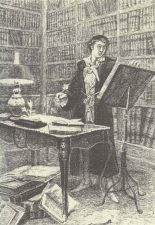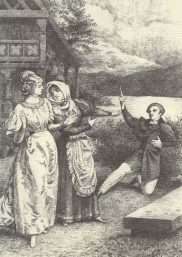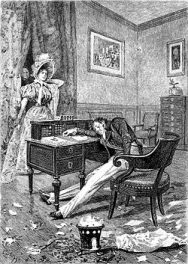
Albert Savarus
LA COMEDIE HUMAINE – Honoré de Balzac First volume of works of Honoré de Balzac edited by widow André Houssiaux, publisher, Hebert and Co, successors, 7 rue Perronet – Paris (1877)

Albert Savarus
ALBERT SAVARUS
Short story serialized in Le Siècle in June 1842.
Analysis of the work Albert Savarus, written in February-May 1842, transposes the story of Honoré de Balzac’s violent disappointment at Madame Hanska’s letter of February 22, 1842, announcing the death of her husband, Count Hanski, and the end of their 9-year affair. Balzac was distraught, seeing an illustrious marriage, a considerable fortune, a brilliant future that he had promised himself from this union, finally the revenge that life owed him, sink at the same time as this great love. The transposition is the story of a young lawyer, unknown to everyone, who moves to Besançon and succeeds in everything: tireless worker, great future, future deputy, future minister. In his past, a great hidden, impossible love that fills his whole life for a very beautiful, very noble, very rich woman who is not free. Her ambition, her immense work in Besançon, had only one aim: to wait, to be able, when she was free, to present herself as rich and famous. He’s right on target. Mutual love will be rewarded. A ploy, some stolen letters, provoke a dramatic misunderstanding and an irreparable decision. The lover, shattered by despair, abandons everything, his future and the fame he was promised, and locks himself away at the Grande Chartreuse. We’ll never hear from him again. Rosalie de Watteville, the only daughter of an old noble family, brought up by a bigoted, hard-line, authoritarian mother and a weak, spineless, spineless husband, is a seemingly docile, silent girl, bent over her work, inscrutable. She spotted Albert Savarus, liked him and came up with a plan. She has a cold, cynical, uncompromising will, a personality that will stop at nothing. She invents a detour of the letters Albert Savarus receives from abroad (from his lover), understands everything, and decides, as a reclusive little girl with nothing but willpower and the spirit of intrigue, to confuse the two lovers and bring the man she has chosen to her knees. The frightening work, the fixed idea that her imagination has generated in her makes her commit a minor’s crime, in which there is both perversity and unconsciousness. After the disaster, life inflicts a punishment on her: she is the victim of an accident in which she is disfigured and crippled. In a perfect imitation of Albert’s handwriting, Rosalie, having substituted Albert’s letters for those of Duchess Francesca d’Argaiolo, had responded to the news of the Duke of Argaiolo’s death with the news of Albert’s forthcoming marriage to her, Rosalie. Purely moral crimes, which leave no room for human justice, are the most infamous, the most odious. Of all the secret crimes buried in the mysteries of private life, one of the most dishonorable is that of surreptitiously reading a letter not intended for us. Anyone, for whatever reason, who indulges in this act has made an indelible mark on his or her probity. Paris, May 1842
Source analysis: Preface compiled from the complete works of the Comédie Humaine (tome III) published by France Loisirs 1985 under the auspices of the Société des Amis d’Honoré de Balzac.
History The Baroness de Watteville, a domineering socialite, ran one of the most popular salons in Besançon. Still seductive, she crushes her lackluster husband and her daughter Rosalie, for whom she is preparing a brilliant marriage with Amédée de Soulas, who is in awe of her mother. But Rosalie has other goals, since a lawyer named Savaron de Savarus has settled in the town, and the young girl is intrigued by his mysterious personality. She secretly loves this ambitious man who is preparing his political career. But Savarus was unwise enough to publish a text, a short story in the fashion of the time, in which he described the amorous adventures of a man with a princess. It’s not hard to guess that this text is autobiographical. Rosalie is deeply annoyed, and then furiously jealous when she realizes that the princess is real.  In a diabolical plot, she intercepts the lawyer’s correspondence and fabricates letters making the princess believe that Savarus, absorbed in his election campaign, no longer feels any love for her. As a result, the widowed princess remarried. And just as the election campaign was beginning in earnest, when Savarus should be at his most active, mad with grief at losing his princess, he disappeared from Besançon. He retired to the Grande Chartreuse convent. Rosalie was unable to savor her victory because, when her father died, her mother remarried Amédée de Soulas, claiming that the young girl had refused. All that’s left is for him to leave Besançon and retire to a property far from the city.
In a diabolical plot, she intercepts the lawyer’s correspondence and fabricates letters making the princess believe that Savarus, absorbed in his election campaign, no longer feels any love for her. As a result, the widowed princess remarried. And just as the election campaign was beginning in earnest, when Savarus should be at his most active, mad with grief at losing his princess, he disappeared from Besançon. He retired to the Grande Chartreuse convent. Rosalie was unable to savor her victory because, when her father died, her mother remarried Amédée de Soulas, claiming that the young girl had refused. All that’s left is for him to leave Besançon and retire to a property far from the city.  Rosalie, in another register, is a manipulator of the same type as La Cousine Bette . Like her, moreover, she’s going to lose herself in her shenanigans. Caught in her own trap, Rosalie’s end is just as sad as Elisabeth Fischer’s.
Rosalie, in another register, is a manipulator of the same type as La Cousine Bette . Like her, moreover, she’s going to lose herself in her shenanigans. Caught in her own trap, Rosalie’s end is just as sad as Elisabeth Fischer’s.
Source story : Wikipedia
Genealogy of characters Watteville: (baron de) Swiss, based in Besançon, died 1836. Married Clotilde-Louise du Rupt, born 1799. A daughter Rosalie was born in 1817. Widowed, Clotilde de Watteville married Amédée de Soulas. Savaron de Savarus: Noble family from Flanders represented by : A damsel who lives in Brabant, an old count. Albert Savarus, born in 1799, was probably the Count’s natural son. He started out as a lawyer, but later became a monk. Amédée de Soulas : Count born in 1809, living in Besançon. In 1837, he married Clotilde du Rupt, widow of Watteville.
Character genealogy source: Félicien Marceau “Balzac et son monde” – Gallimard
No Comments